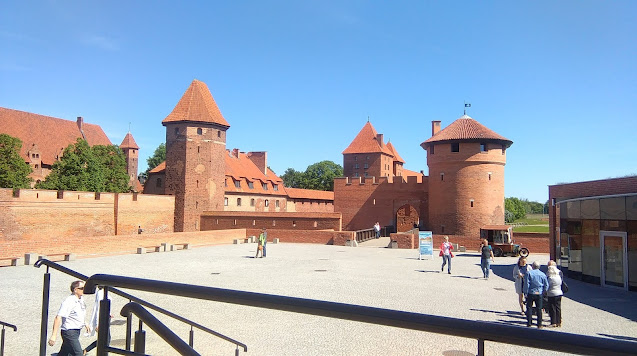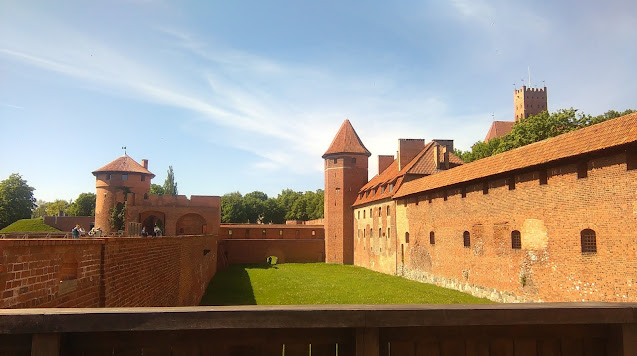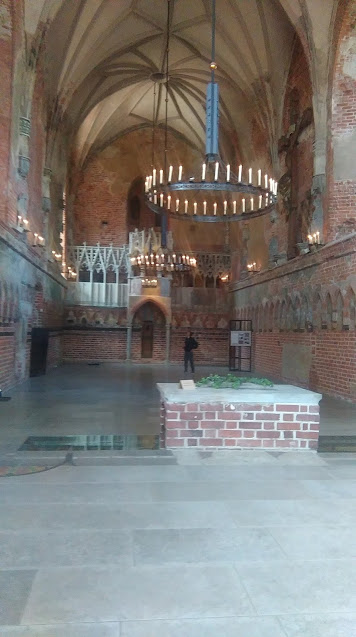The Castle of the Teutonic Order in Malbork (Zamek w Malborku) is a 13th-century Teutonic castle and fortress located on the Nogat River near the town of Malbork. It is recognized as the largest castle in the world based on land area and is designated as a UNESCO World Heritage Site.
Originally built in 1406 by the Teutonic Knights, a German Catholic religious order of crusaders, the castle was constructed as an Ordensburg fortress. Its primary purpose was to consolidate the Order's control in the region following their suppression of the Great Prussian Uprising of the Baltic tribes in 1274. The castle was named Marienburg in honor of Mary, the mother of Jesus. In 1457, during the Thirteen Years' War, it was sold by Bohemian mercenaries to King Casimir IV of Poland and subsequently served as one of several Polish royal residences. From 1772, the castle came under German rule for over 170 years. After Germany's defeat in World War II in 1945, the land was assigned to Poland by the Allies. The castle suffered extensive damage but was renovated in the second half of the 20th century and most recently in 2016.
As no contemporary documents relating to its construction have survived, the castle's architectural phases have been deduced through the study of its architecture, the Order's administrative records, and later historical accounts. The construction work extended until around 1300. Over time, the castle was expanded to accommodate the growing number of knights and became the largest fortified Gothic building in Europe, covering nearly 21 hectares. It consists of three separate castles—the High, Middle, and Lower Castles—separated by multiple dry moats and towers. At its height, the castle housed approximately 3,000 "brothers in arms."
The castle's strategic location on the Nogat River provided easy access for barges and trading ships traveling from the Vistula River and the Baltic Sea. Under Teutonic Knights' rule, river tolls were collected from passing ships, similar to other castles along the rivers. The knights maintained a monopoly on the trade of amber.
During the summer of 1410, the castle was besieged following the Order's defeat by the armies of Władysław II Jagiełło and Vytautas the Great at the Battle of Grunwald. In 1456, facing financial difficulties due to opposition from cities under its control and the costs of its wars against the Kingdom of Poland, the Order could no longer sustain itself.
In 1466, both the castle and town became part of the Polish Malbork Voivodeship in the province of Royal Prussia. It served as a Polish royal residence for over 300 years until the Partitions of Poland in 1772. During the Thirty Years' War, Swedish forces occupied the castle in 1626 and 1629, and during the Deluge, they invaded and occupied it again from 1656 to 1660.
After the Partition of Poland in 1772, the town became part of the Kingdom of Prussia. At that time, the castle was used as a poorhouse and barracks for the Prussian Army. In the early 1930s, during Adolf Hitler's rise to power, the Nazis utilized the castle for annual pilgrimages of the Hitler Youth and the League of German Girls. The Teutonic Castle at Marienburg served as a model for the Order Castles constructed during Hitler's reign. During World War II, over half of the castle was destroyed in combat.
At the end of the war, the city of Marienburg (Malbork) and the castle became part of Poland. The castle has undergone extensive reconstruction, with restoration efforts ongoing since 1962 after a fire in 1959 caused additional damage. Notably, the main church within the castle, The Blessed Virgin Mary Church, underwent significant recent restoration, completed in April 2016. Malbork Castle remains the largest brick building in Europe.




















0 komentarze:
Post a Comment